four wheel drive MAZDA MODEL TRIBUTE 2008 Owners Manual (in English)
[x] Cancel search | Manufacturer: MAZDA, Model Year: 2008, Model line: MODEL TRIBUTE, Model: MAZDA MODEL TRIBUTE 2008Pages: 288, PDF Size: 3.9 MB
Page 125 of 288
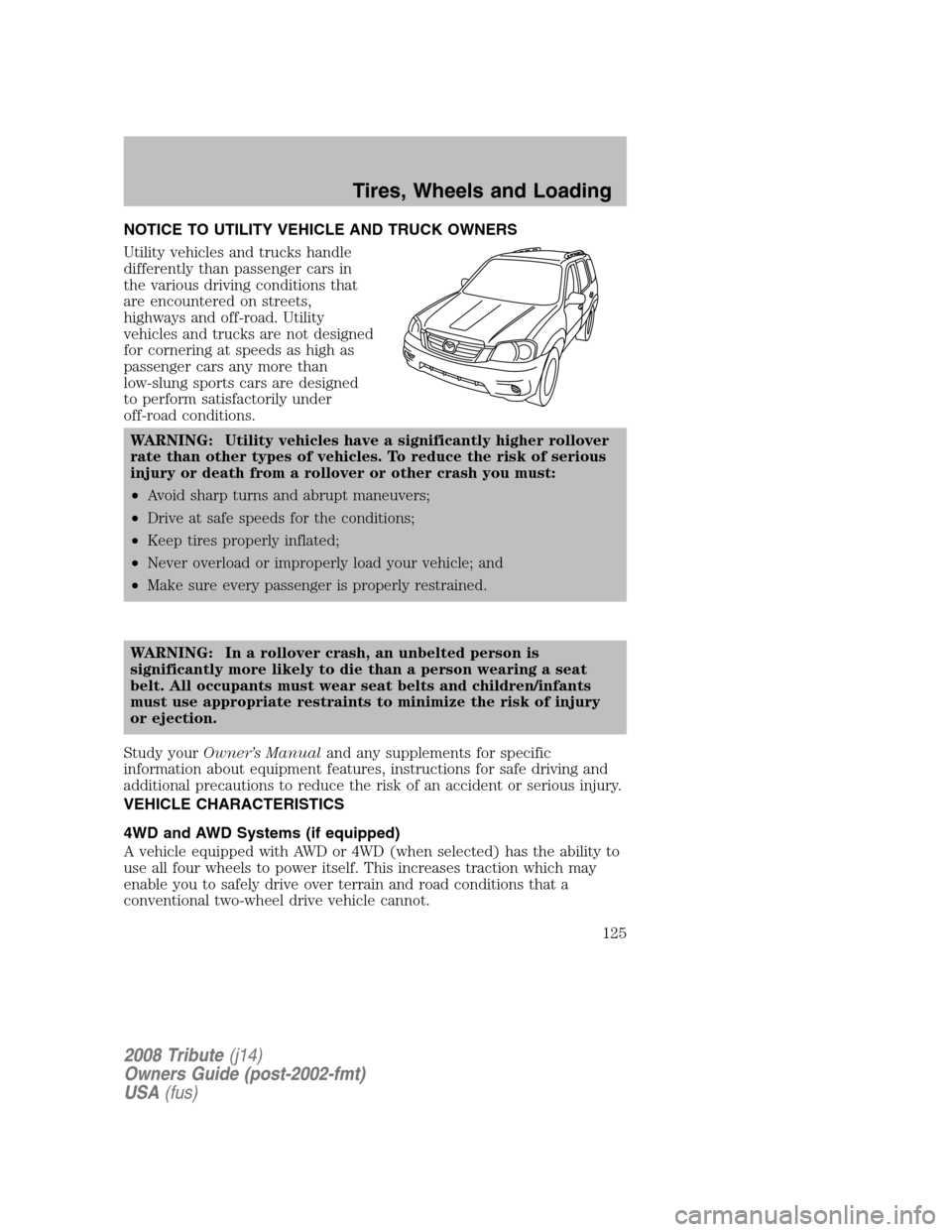
NOTICE TO UTILITY VEHICLE AND TRUCK OWNERS
Utility vehicles and trucks handle
differently than passenger cars in
the various driving conditions that
are encountered on streets,
highways and off-road. Utility
vehicles and trucks are not designed
for cornering at speeds as high as
passenger cars any more than
low-slung sports cars are designed
to perform satisfactorily under
off-road conditions. WARNING: Utility vehicles have a significantly higher rollover
rate than other types of vehicles. To reduce the risk of serious
injury or death from a rollover or other crash you must:
• Avoid sharp turns and abrupt maneuvers;
• Drive at safe speeds for the conditions;
• Keep tires properly inflated;
• Never overload or improperly load your vehicle; and
• Make sure every passenger is properly restrained.
WARNING: In a rollover crash, an unbelted person is
significantly more likely to die than a person wearing a seat
belt. All occupants must wear seat belts and children/infants
must use appropriate restraints to minimize the risk of injury
or ejection.
Study your Owner’s Manual and any supplements for specific
information about equipment features, instructions for safe driving and
additional precautions to reduce the risk of an accident or serious injury.
VEHICLE CHARACTERISTICS
4WD and AWD Systems (if equipped)
A vehicle equipped with AWD or 4WD (when selected) has the ability to
use all four wheels to power itself. This increases traction which may
enable you to safely drive over terrain and road conditions that a
conventional two-wheel drive vehicle cannot.
2008 Tribute (j14)
Owners Guide (post-2002-fmt)
USA (fus)
Tires, Wheels and Loading
125
Page 126 of 288
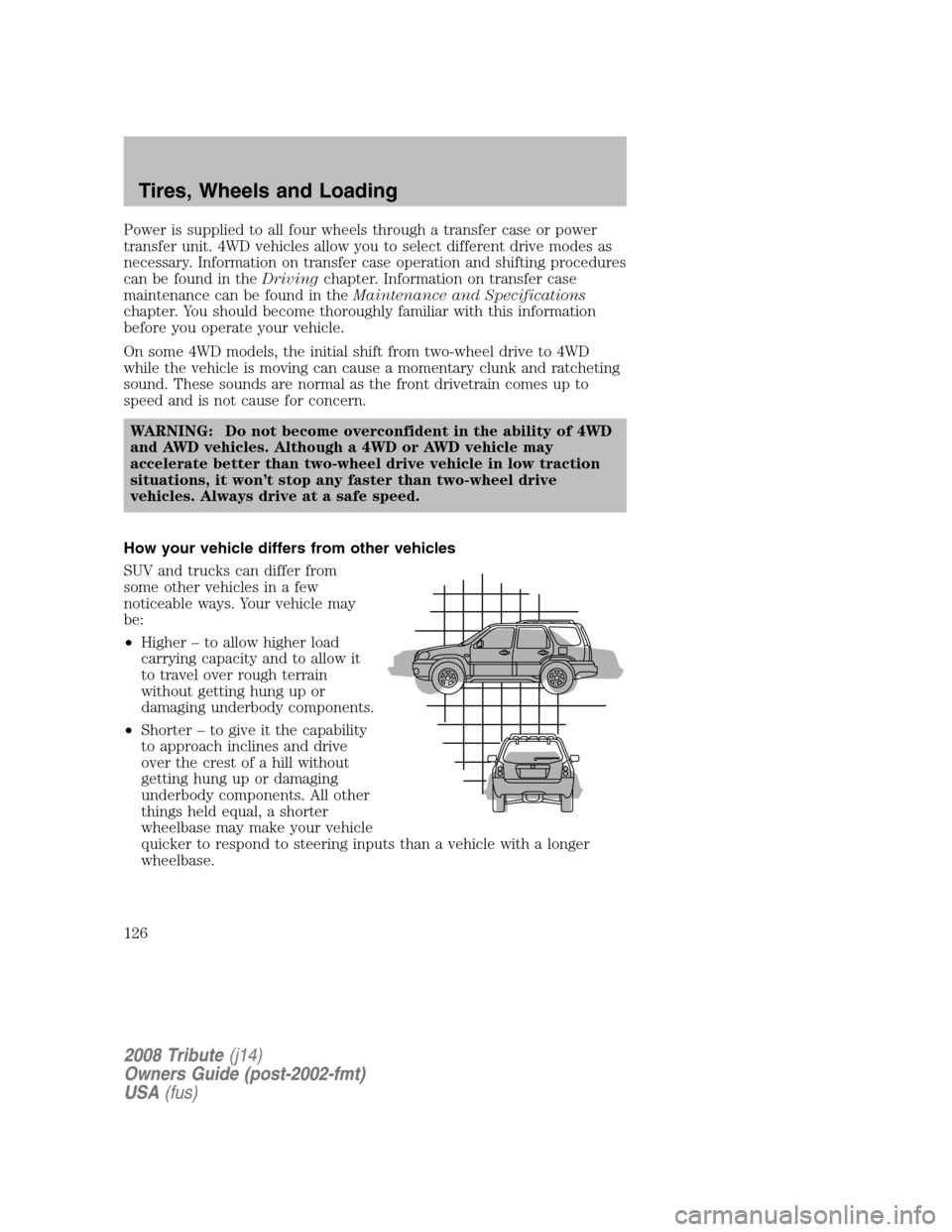
Power is supplied to all four wheels through a transfer case or power
transfer unit. 4WD vehicles allow you to select different drive modes as
necessary. Information on transfer case operation and shifting procedures
can be found in the Drivingchapter. Information on transfer case
maintenance can be found in the Maintenance and Specifications
chapter. You should become thoroughly familiar with this information
before you operate your vehicle.
On some 4WD models, the initial shift from two-wheel drive to 4WD
while the vehicle is moving can cause a momentary clunk and ratcheting
sound. These sounds are normal as the front drivetrain comes up to
speed and is not cause for concern.
WARNING: Do not become overconfident in the ability of 4WD
and AWD vehicles. Although a 4WD or AWD vehicle may
accelerate better than two-wheel drive vehicle in low traction
situations, it won’t stop any faster than two-wheel drive
vehicles. Always drive at a safe speed.
How your vehicle differs from other vehicles
SUV and trucks can differ from
some other vehicles in a few
noticeable ways. Your vehicle may
be:
• Higher – to allow higher load
carrying capacity and to allow it
to travel over rough terrain
without getting hung up or
damaging underbody components.
• Shorter – to give it the capability
to approach inclines and drive
over the crest of a hill without
getting hung up or damaging
underbody components. All other
things held equal, a shorter
wheelbase may make your vehicle
quicker to respond to steering inputs than a vehicle with a longer
wheelbase.
2008 Tribute (j14)
Owners Guide (post-2002-fmt)
USA (fus)
Tires, Wheels and Loading
126
Page 136 of 288
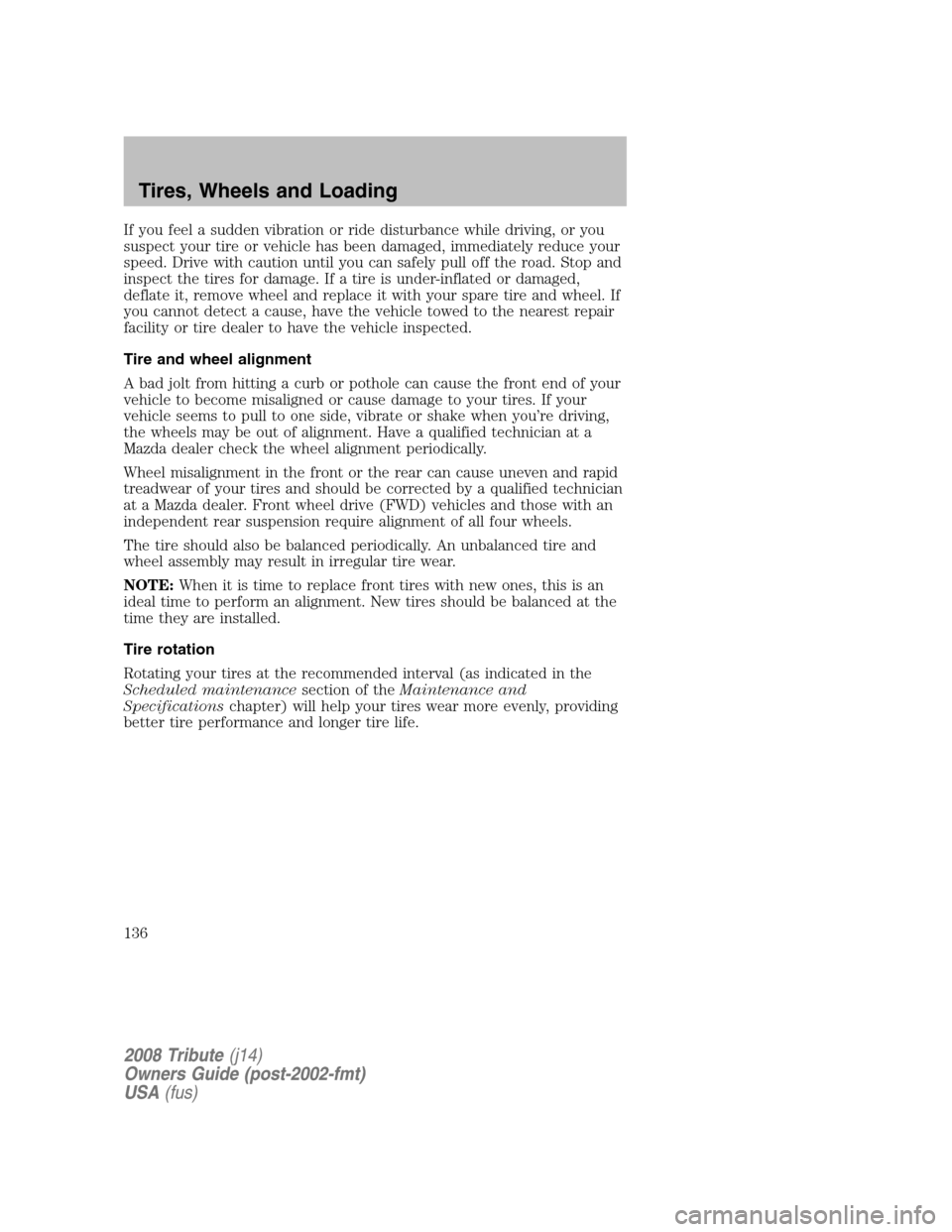
If you feel a sudden vibration or ride disturbance while driving, or you
suspect your tire or vehicle has been damaged, immediately reduce your
speed. Drive with caution until you can safely pull off the road. Stop and
inspect the tires for damage. If a tire is under-inflated or damaged,
deflate it, remove wheel and replace it with your spare tire and wheel. If
you cannot detect a cause, have the vehicle towed to the nearest repair
facility or tire dealer to have the vehicle inspected.
Tire and wheel alignment
A bad jolt from hitting a curb or pothole can cause the front end of your
vehicle to become misaligned or cause damage to your tires. If your
vehicle seems to pull to one side, vibrate or shake when you’re driving,
the wheels may be out of alignment. Have a qualified technician at a
Mazda dealer check the wheel alignment periodically.
Wheel misalignment in the front or the rear can cause uneven and rapid
treadwear of your tires and should be corrected by a qualified technician
at a Mazda dealer. Front wheel drive (FWD) vehicles and those with an
independent rear suspension require alignment of all four wheels.
The tire should also be balanced periodically. An unbalanced tire and
wheel assembly may result in irregular tire wear.
NOTE: When it is time to replace front tires with new ones, this is an
ideal time to perform an alignment. New tires should be balanced at the
time they are installed.
Tire rotation
Rotating your tires at the recommended interval (as indicated in the
Scheduled maintenance section of theMaintenance and
Specifications chapter) will help your tires wear more evenly, providing
better tire performance and longer tire life.
2008 Tribute (j14)
Owners Guide (post-2002-fmt)
USA (fus)
Tires, Wheels and Loading
136
Page 137 of 288
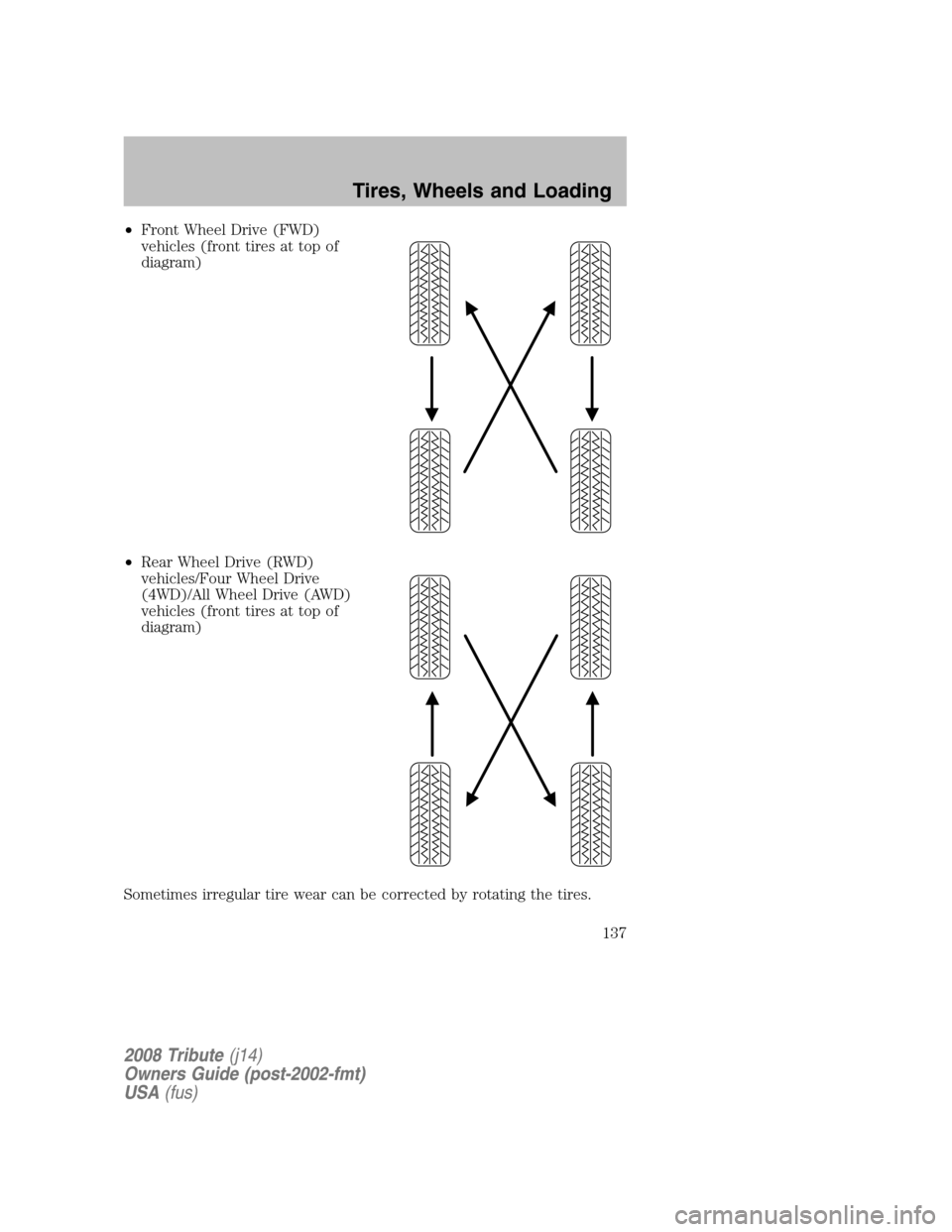
•Front Wheel Drive (FWD)
vehicles (front tires at top of
diagram)
• Rear Wheel Drive (RWD)
vehicles/Four Wheel Drive
(4WD)/All Wheel Drive (AWD)
vehicles (front tires at top of
diagram)
Sometimes irregular tire wear can be corrected by rotating the tires.
2008 Tribute (j14)
Owners Guide (post-2002-fmt)
USA (fus)
Tires, Wheels and Loading
137
Page 140 of 288

8.U.S. DOT Tire Identification Number (TIN): This begins with
the letters “DOT” and indicates that the tire meets all federal
standards. The next two numbers or letters are the plant code
designating where it was manufactured, the next two are the tire
size code and the last four numbers represent the week and year the
tire was built. For example, the numbers 317 mean the 31st week of
1997. After 2000 the numbers go to four digits. For example, 2501
means the 25th week of 2001. The numbers in between are
identification codes used for traceability. This information is used to
contact customers if a tire defect requires a recall.
9. M+S or M/S: Mud and Snow, or
AT: All Terrain, or
AS: All Season.
10. Tire Ply Composition and Material Used: Indicates the number
of plies or the number of layers of rubber-coated fabric in the tire
tread and sidewall. Tire manufacturers also must indicate the ply
materials in the tire and the sidewall, which include steel, nylon,
polyester, and others.
11. Maximum Load: Indicates the maximum load in kilograms and
pounds that can be carried by the tire. Refer to the Safety
Compliance Certification Label, which is located on the B-Pillar or
the edge of the driver’s door, for the correct tire pressure for your
vehicle.
12. Treadwear, Traction and Temperature Grades
• Treadwear: The treadwear grade is a comparative rating based on the
wear rate of the tire when tested under controlled conditions on a
specified government test course. For example, a tire graded 150
would wear one and one-half (1
1�2) times as well on the government
course as a tire graded 100.
• Traction: The traction grades, from highest to lowest are AA, A, B,
and C. The grades represent the tire’s ability to stop on wet pavement
as measured under controlled conditions on specified government test
surfaces of asphalt and concrete. A tire marked C may have poor
traction performance.
• Temperature: The temperature grades are A (the highest), B and C,
representing the tire’s resistance to the generation of heat and its
ability to dissipate heat when tested under controlled conditions on a
specified indoor laboratory test wheel.
2008 Tribute (j14)
Owners Guide (post-2002-fmt)
USA (fus)
Tires, Wheels and Loading
140
Page 141 of 288
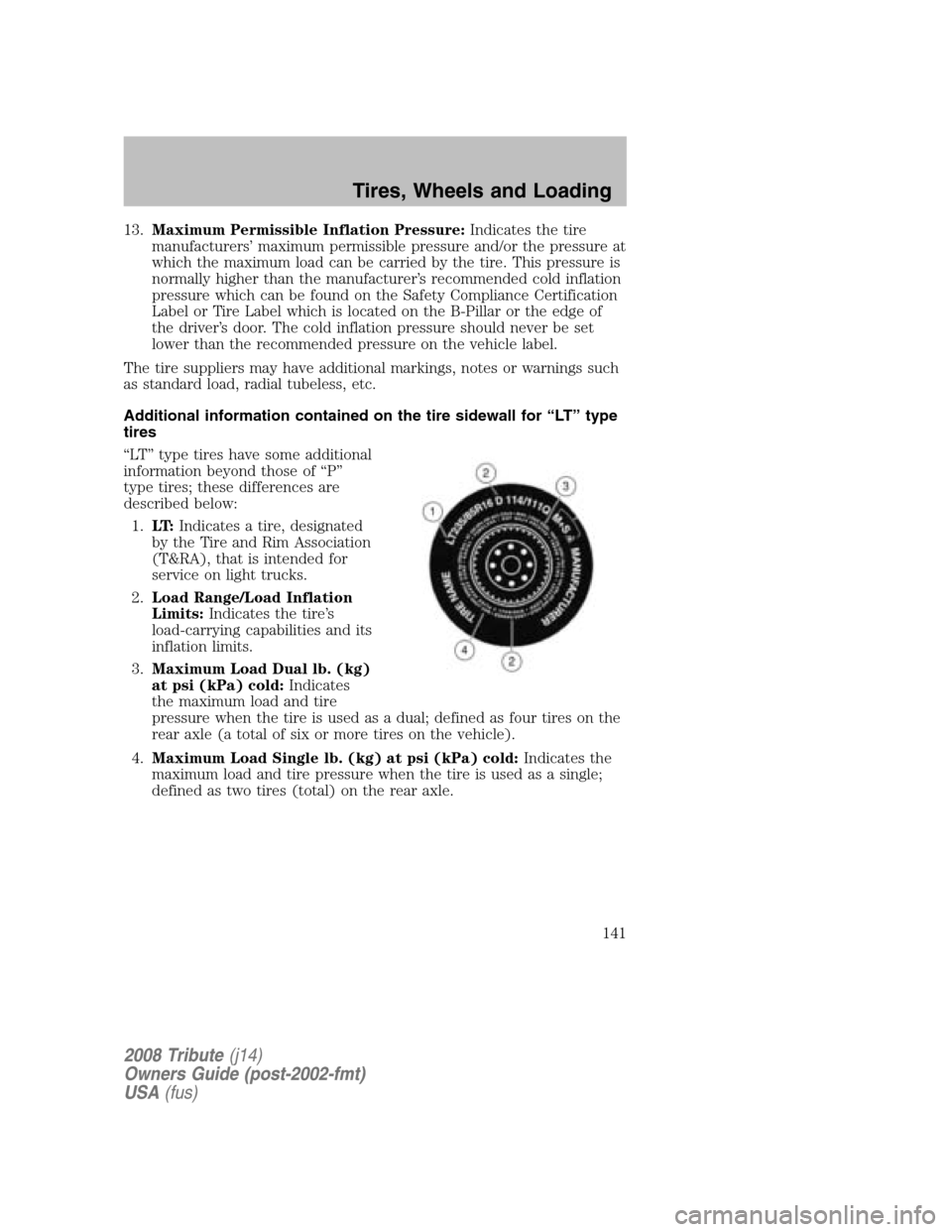
13.Maximum Permissible Inflation Pressure: Indicates the tire
manufacturers’ maximum permissible pressure and/or the pressure at
which the maximum load can be carried by the tire. This pressure is
normally higher than the manufacturer’s recommended cold inflation
pressure which can be found on the Safety Compliance Certification
Label or Tire Label which is located on the B-Pillar or the edge of
the driver’s door. The cold inflation pressure should never be set
lower than the recommended pressure on the vehicle label.
The tire suppliers may have additional markings, notes or warnings such
as standard load, radial tubeless, etc.
Additional information contained on the tire sidewall for “LT” type
tires
“LT” type tires have some additional
information beyond those of “P”
type tires; these differences are
described below: 1. LT: Indicates a tire, designated
by the Tire and Rim Association
(T&RA), that is intended for
service on light trucks.
2. Load Range/Load Inflation
Limits: Indicates the tire’s
load-carrying capabilities and its
inflation limits.
3. Maximum Load Dual lb. (kg)
at psi (kPa) cold: Indicates
the maximum load and tire
pressure when the tire is used as a dual; defined as four tires on the
rear axle (a total of six or more tires on the vehicle).
4. Maximum Load Single lb. (kg) at psi (kPa) cold: Indicates the
maximum load and tire pressure when the tire is used as a single;
defined as two tires (total) on the rear axle.
2008 Tribute (j14)
Owners Guide (post-2002-fmt)
USA (fus)
Tires, Wheels and Loading
141
Page 153 of 288

WARNING: Exceeding any vehicle weight rating limitation
could result in serious damage to the vehicle and/or personal
injury.
Steps for determining the correct load limit: 1. Locate the statement “The combined weight of occupants and cargo should never exceed XXX kg or XXX lbs.” on your vehicle’s placard.
2. Determine the combined weight of the driver and passengers that will be riding in your vehicle.
3. Subtract the combined weight of the driver and passengers from XXX kg or XXX lbs.
4. The resulting figure equals the available amount of cargo and luggage load capacity. For example, if the “XXX” amount equals
1,400 lbs. and there will be five 150 lb. passengers in your vehicle,
the amount of available cargo and luggage load capacity is 650 lbs.
(1400-750 (5 x 150) = 650 lb.). In metric units (635-340 (5 x 68) =
295 kg.)
5. Determine the combined weight of luggage and cargo being loaded on the vehicle. That weight may not safely exceed the available
cargo and luggage load capacity calculated in Step 4.
6. If your vehicle will be towing a trailer, load from your trailer will be transferred to your vehicle. Consult this manual to determine how
this reduces the available cargo and luggage load capacity of your
vehicle.
The following gives you a few examples on how to calculate the available
amount of cargo and luggage load capacity:
• Another example for your vehicle with 1400 lb. (635 kg) of cargo and
luggage capacity. You decide to go golfing. Is there enough load
capacity to carry you, 4 of your friends and all the golf bags? You and
four friends average 220 lb. (99 kg) each and the golf bags weigh
approximately 30 lb. (13.5 kg) each. The calculation would be:
1400 - (5 x 220) - (5 x 30) = 1400 - 1100 - 150 = 150 lb. Yes, you
have enough load capacity in your vehicle to transport four friends
and your golf bags. In metric units, the calculation would be: 635 kg -
(5 x 99 kg) - (5 x 13.5 kg) = 635 - 495 - 67.5 = 72.5 kg.
2008 Tribute (j14)
Owners Guide (post-2002-fmt)
USA (fus)
Tires, Wheels and Loading
153
Page 160 of 288
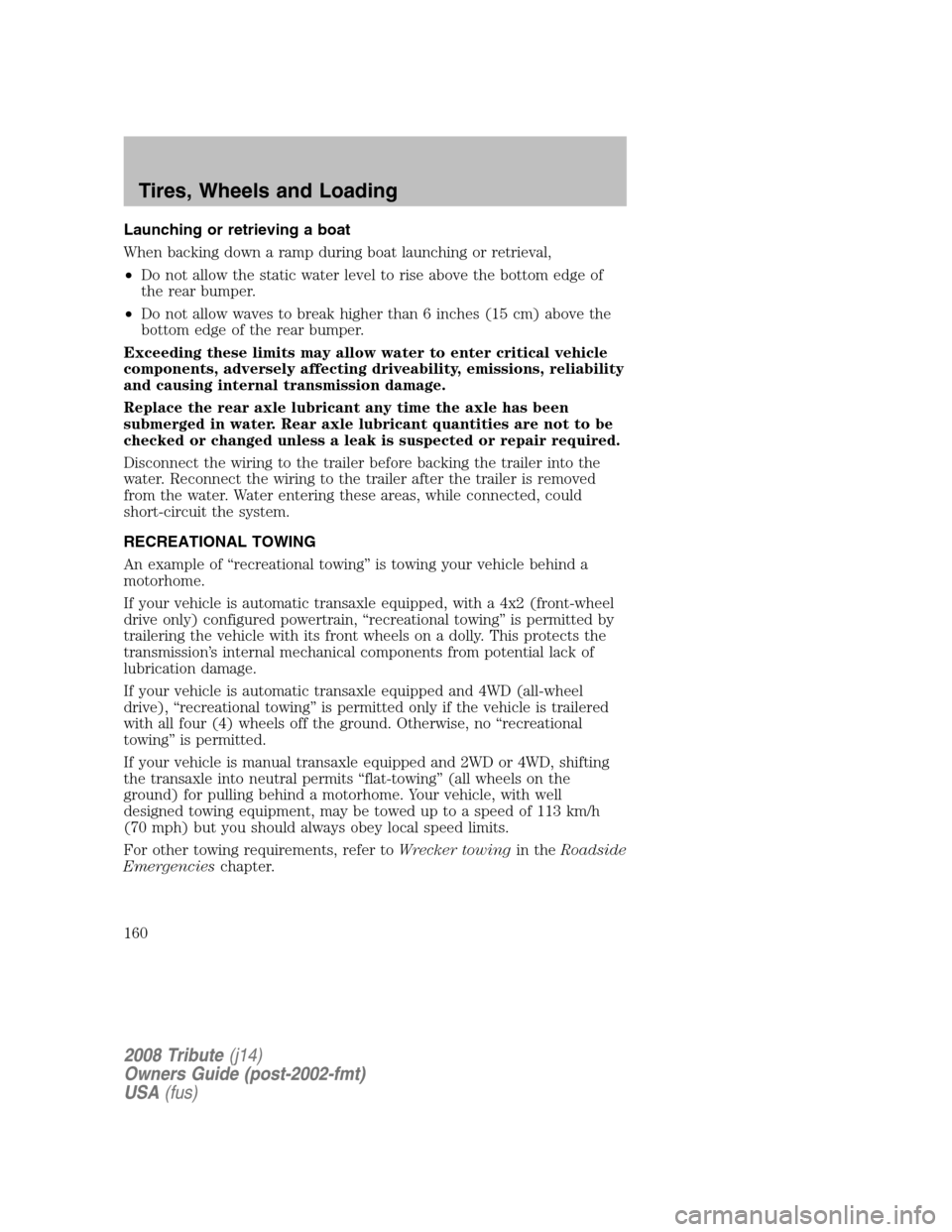
Launching or retrieving a boat
When backing down a ramp during boat launching or retrieval,
• Do not allow the static water level to rise above the bottom edge of
the rear bumper.
• Do not allow waves to break higher than 6 inches (15 cm) above the
bottom edge of the rear bumper.
Exceeding these limits may allow water to enter critical vehicle
components, adversely affecting driveability, emissions, reliability
and causing internal transmission damage.
Replace the rear axle lubricant any time the axle has been
submerged in water. Rear axle lubricant quantities are not to be
checked or changed unless a leak is suspected or repair required.
Disconnect the wiring to the trailer before backing the trailer into the
water. Reconnect the wiring to the trailer after the trailer is removed
from the water. Water entering these areas, while connected, could
short-circuit the system.
RECREATIONAL TOWING
An example of “recreational towing” is towing your vehicle behind a
motorhome.
If your vehicle is automatic transaxle equipped, with a 4x2 (front-wheel
drive only) configured powertrain, “recreational towing” is permitted by
trailering the vehicle with its front wheels on a dolly. This protects the
transmission’s internal mechanical components from potential lack of
lubrication damage.
If your vehicle is automatic transaxle equipped and 4WD (all-wheel
drive), “recreational towing” is permitted only if the vehicle is trailered
with all four (4) wheels off the ground. Otherwise, no “recreational
towing” is permitted.
If your vehicle is manual transaxle equipped and 2WD or 4WD, shifting
the transaxle into neutral permits “flat-towing” (all wheels on the
ground) for pulling behind a motorhome. Your vehicle, with well
designed towing equipment, may be towed up to a speed of 113 km/h
(70 mph) but you should always obey local speed limits.
For other towing requirements, refer to Wrecker towingin theRoadside
Emergencies chapter.
2008 Tribute (j14)
Owners Guide (post-2002-fmt)
USA (fus)
Tires, Wheels and Loading
160
Page 166 of 288

BRAKES
Occasional brake noise is normal. If a metal-to-metal, continuous grinding
or continuous squeal sound is present, the brake linings may be worn-out
and should be inspected by an authorized dealer. If the vehicle has
continuous vibration or shudder in the steering wheel while braking, the
vehicle should be inspected by an authorized dealer.
Refer to Brake system warning
light in the Instrument Cluster
chapter for information on the brake
system warning light.
Four-wheel anti-lock brake system (ABS)
Since your vehicle is equipped with an Anti-lock Braking System (ABS),
a noise from the hydraulic pump motor and pulsation in the pedal may
be observed during ABS braking events. Pedal pulsation coupled with
noise while braking under panic conditions or on loose gravel, bumps,
wet or snowy roads is normal and indicates proper functioning of the
vehicle’s anti-lock brake system.
NOTE: The ABS performs a self-check after you start the engine and
begin to drive away.
A brief mechanical noise may be heard during this test. This is normal. If
a malfunction is found, the ABS warning light will come on. If the vehicle
has continuous vibration or shudder in the steering wheel while braking,
the vehicle should be inspected by an authorized dealer.
The ABS operates by detecting the
onset of wheel lockup during brake
applications and compensates for
this tendency. The wheels are
prevented from locking even when
the brakes are firmly applied. The
accompanying illustration depicts
the advantage of an ABS equipped
vehicle (on bottom) to a non-ABS
equipped vehicle (on top) during hard braking with loss of front braking
traction.
WARNING: The Anti-Lock system does not decrease the time
necessary to apply the brakes or always reduce stopping
distance. Always leave enough room between your vehicle and
the vehicle in front of you to stop.
P!
BRAKE
2008 Tribute (j14)
Owners Guide (post-2002-fmt)
USA (fus)
Driving
166
Page 181 of 288
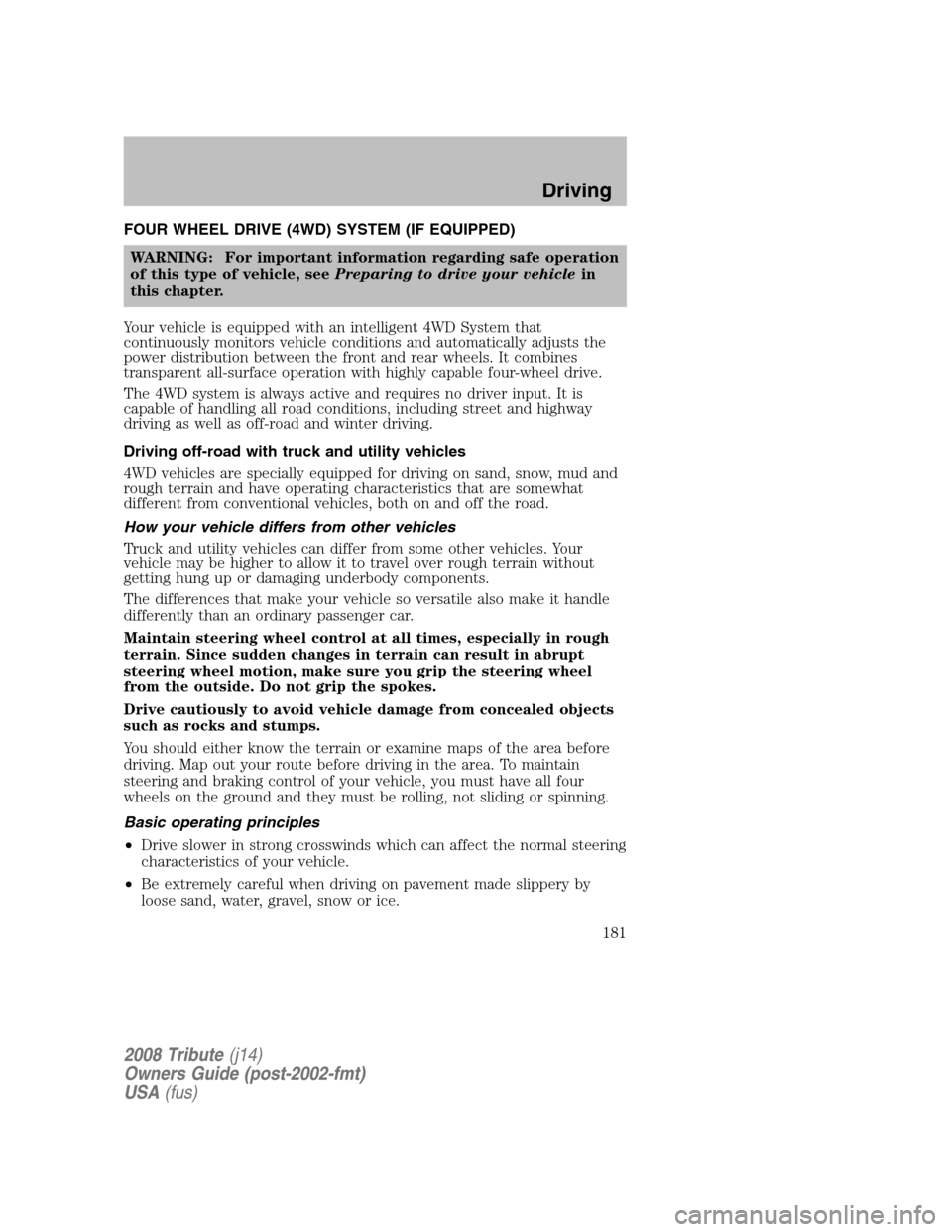
FOUR WHEEL DRIVE (4WD) SYSTEM (IF EQUIPPED) WARNING: For important information regarding safe operation
of this type of vehicle, see Preparing to drive your vehicle in
this chapter.
Your vehicle is equipped with an intelligent 4WD System that
continuously monitors vehicle conditions and automatically adjusts the
power distribution between the front and rear wheels. It combines
transparent all-surface operation with highly capable four-wheel drive.
The 4WD system is always active and requires no driver input. It is
capable of handling all road conditions, including street and highway
driving as well as off-road and winter driving.
Driving off-road with truck and utility vehicles
4WD vehicles are specially equipped for driving on sand, snow, mud and
rough terrain and have operating characteristics that are somewhat
different from conventional vehicles, both on and off the road.
How your vehicle differs from other vehicles
Truck and utility vehicles can differ from some other vehicles. Your
vehicle may be higher to allow it to travel over rough terrain without
getting hung up or damaging underbody components.
The differences that make your vehicle so versatile also make it handle
differently than an ordinary passenger car.
Maintain steering wheel control at all times, especially in rough
terrain. Since sudden changes in terrain can result in abrupt
steering wheel motion, make sure you grip the steering wheel
from the outside. Do not grip the spokes.
Drive cautiously to avoid vehicle damage from concealed objects
such as rocks and stumps.
You should either know the terrain or examine maps of the area before
driving. Map out your route before driving in the area. To maintain
steering and braking control of your vehicle, you must have all four
wheels on the ground and they must be rolling, not sliding or spinning.
Basic operating principles
• Drive slower in strong crosswinds which can affect the normal steering
characteristics of your vehicle.
• Be extremely careful when driving on pavement made slippery by
loose sand, water, gravel, snow or ice.
2008 Tribute (j14)
Owners Guide (post-2002-fmt)
USA (fus)
Driving
181